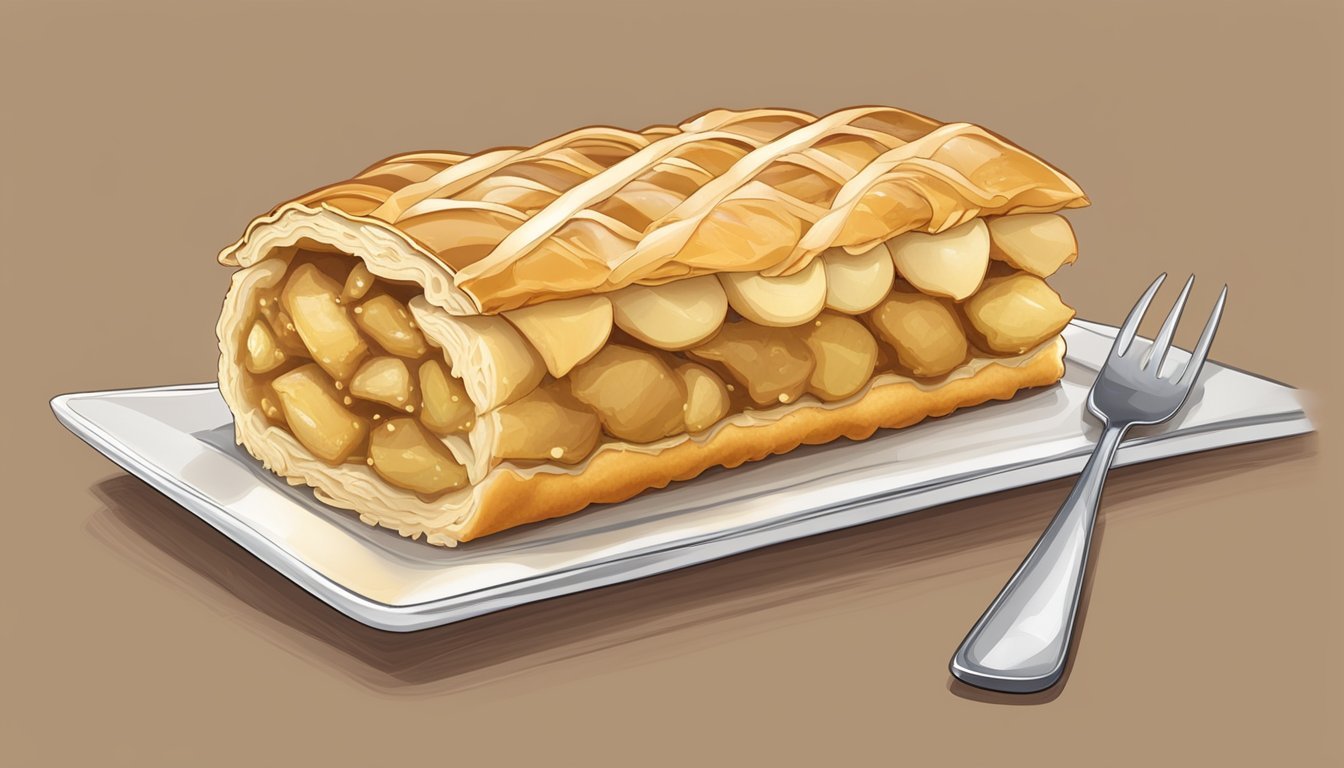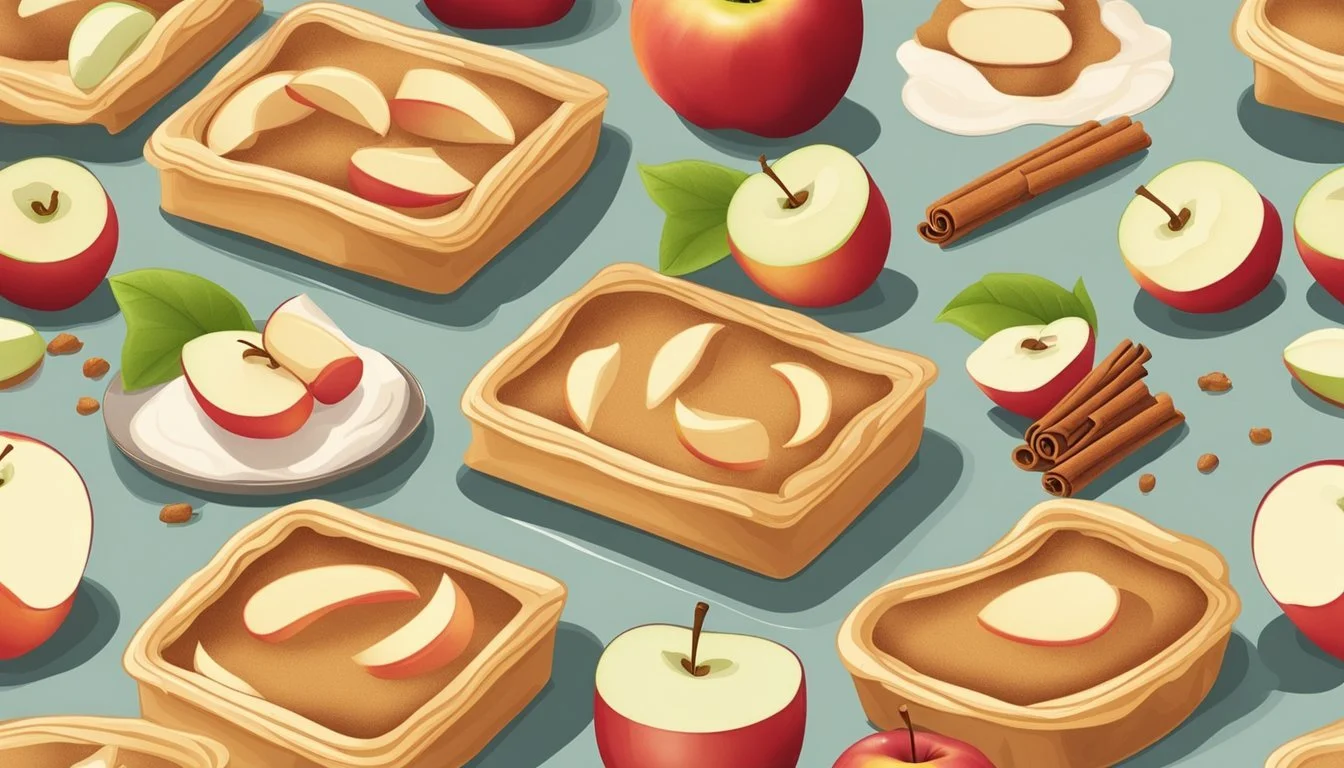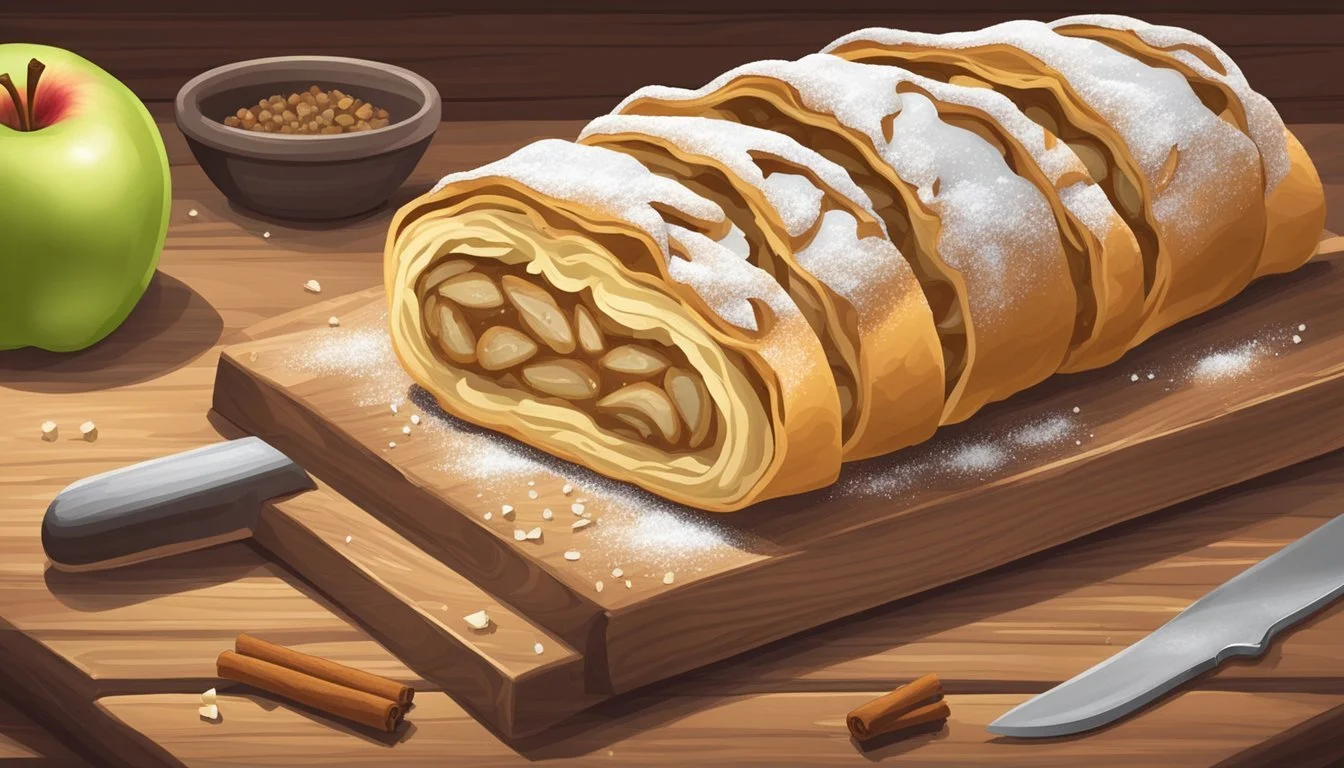How Do You Eat an Apple Strudel?
Serving and Enjoyment Tips
Eating an apple strudel offers a delightful experience that combines textures and flavors into a satisfying dessert (What wine goes well with desserts?). This traditional pastry, characterized by its flaky crust and sweet apple filling, is a staple in many European bakeries, particularly those with German or Austrian heritage. The pastry is carefully crafted with a light and buttery dough that encases a mixture of tart apples, sugar, and warm spices, typically cinnamon, and occasionally raisins or nuts for added texture.
To enjoy an apple strudel, it is typically warmed to enhance the flavor and texture of the filling, ensuring that the spices' aroma is more pronounced and inviting. The strudel can be sliced into individual servings, making it convenient for people to savor the blend of the crisp pastry with the soft, fragrant apple interior. It is commonly accompanied by a sprinkle of powdered sugar on top, adding an extra touch of sweetness.
Often, apple strudel is served with a dollop of whipped cream, a scoop of vanilla ice cream, or a side of custard, enriching the dessert experience with creamy components that complement the spiced apple flavor. This dessert not only pleases the palate with its delicious combination of flavors and textures but also presents a comforting and homely treat perfect for any occasion.
History and Origin
The apple strudel is a pastry with deep historical roots, primarily connected to Austria, though it is often erroneously thought to have originated from Germany. The earliest recorded recipe dates back to the 17th century.
Cultural Significance
The apple strudel holds significant cultural value in Austria, where it is sometimes referred to as the national dish. This dessert became notably popular in the 18th century during the Austro-Hungarian Empire. The name "strudel" itself comes from a German word meaning "whirlpool" or "eddy", resonating with the dessert's layered appearance which is reminiscent of a spiraling vortex.
The strudel is not only a culinary delight in Austria but also carries a sense of national identity and pride. This importance is mirrored in Viennese cafés, where the apple strudel is a common and cherished treat. The strudel's fame has traversed beyond the boundaries of Austria and Bavaria, placing it on the global stage as a symbol of Viennese baking tradition. While the dessert is closely associated with Austrian culture, its influence can be seen in the German region of Bavaria, where similar traditions and appreciation for the pastry can be found.
Essential Ingredients
Crafting the perfect apple strudel requires a harmonious blend of the right fruit, a flaky pastry dough, and a selection of complementary flavorings to elevate the overall taste.
Choosing Apples
The apple is the star of the strudel and choosing the right type is crucial. Granny Smith apples are often preferred for their tartness and firm texture, which hold up well during baking. They are balanced in flavor and keep their distinct shape, providing a satisfying texture in each bite.
Ideal apple traits for strudel:
Tartness
Firmness
Flavor retention
Dough Basics
The dough for an apple strudel should be thin, light, and flaky. Traditionally, strudel dough contains flour, water, oil, and a pinch of salt. It requires careful stretching to achieve a near-transparent thinness before it's filled and rolled. A well-made dough ensures a delicate pastry that complements the rich filling.
Essential dough components:
Flour
Water
Oil (for elasticity)
Salt (for flavor)
Additional Flavorings
To enhance the apple filling of the strudel, several additional ingredients are used:
Sweetness: Granulated sugar blends with the natural sugars of apples, caramelizing slightly during baking, enhancing the dessert's sweet profile.
Spices: Cinnamon is the classic spice choice for apple strudel, infusing warmth and depth into the apple mixture.
Texture: A mixture of breadcrumbs, chopped walnuts, or slivered almonds can add a delightful crunch, while golden raisins or regular raisins soaked in water or rum bring a chewy sweetness.
Additional flavorful ingredients:
Cinnamon
Sugar (Granulated or Brown)
Golden raisins or raisins
Breadcrumbs for absorbing excess juice
Nuts (Walnuts or Almonds) for crunch
Preparing the Dough
The foundation of a delicious apple strudel is its dough, which must be thin yet sturdy enough to encase the filling without tearing. The key lies in achieving the perfect texture and mastering the rolling technique.
Creating the Perfect Texture
Strudel dough, unlike puff pastry or phyllo dough, should be elastic and malleable to allow for stretching. Using all-purpose flour is standard for its ability to develop gluten, which is crucial for the dough's elasticity. Strudel makers begin by combining the flour with water, a small amount of oil, and a pinch of salt. They mix these ingredients until a firm dough forms.
Ingredients:
All-purpose flour: The base for gluten development.
Water: Hydrates the flour, aiding in gluten formation.
Oil: Adds pliability to the dough, making it easier to work with.
Salt: Enhances the flavor and strengthens the gluten network.
Mixing:
Combine the ingredients in a bowl and knead until a smooth dough forms.
Allow the dough to rest, usually covered with a warm bowl, to relax the gluten.
Resting time varies, but a minimum of 30 minutes is recommended for ideal texture.
Dough Rolling Techniques
Once rested, the strudel dough requires careful rolling. Strudel experts often use a floured cloth or large table to begin expanding the dough.
Rolling:
Start by rolling the dough with a rolling pin into a rough rectangle.
Gradually stretch the dough using the backs of the hands, working from the center outwards, ensuring it remains evenly thin.
Thickness:
The dough should ideally be thin enough for the work surface to be vaguely visible through it.
One aims for a tissue-thin texture, yet it must be resilient, signifying well-developed gluten.
Handling:
Handle the dough delicately to prevent tears.
Address any small rips by pinching the dough together lightly.
Through careful mixing and precise rolling, the perfect strudel dough becomes the canvas for a flaky pastry, ready to be filled with sweet or savory ingredients.
Filling Preparation
The key to an indulgent apple strudel lies in the mastery of its filling. An impeccable balance of sweetness, spices, and textures is essential.
Mixing the Right Balance
One begins by stirring together peeled and thinly sliced apples, preferably a mix that includes Honeycrisp for their balance of sweetness and tartness. Adding brown sugar and spices like cinnamon and a hint of nutmeg ensures the filling develops a rich, spiced flavor profile. Lemon juice is often drizzled onto the apple mixture, providing a subtle acidity that brightens the overall taste.
The inclusion of golden raisins is a classic choice; for an added depth of flavor, raisins may be soaked in rum beforehand. Optional ingredients like chopped walnuts create a pleasant crunch, contrasting the soft apple slices. Before assembling, the ingredients must thoroughly combine to ensure each bite of the strudel holds the full spectrum of flavors.
To bind and enrich the mixture, small amounts of flour are typically sprinkled in to absorb excess moisture, preventing the pastry from becoming soggy. The filling is often dotted with butter just before it’s enclosed within the pastry to introduce a layer of richness.
An egg wash, lightly brushed over the pastry before baking, will impart a golden hue and delightful crispness to the finished product. Each of these components plays a pivotal role in creating a memorable filling that perfectly compliments the flaky crust of the apple strudel.
Assembling the Strudel
Creating a homemade apple strudel involves careful layering ingredients to achieve a flaky crust and a tender, flavorful filling. The process involves wrapping thinly rolled dough around a luscious apple mixture, resulting in a delightful pastry.
Layering Elements
One begins the assembly by laying out thin sheets of strudel dough on a sheet of plastic wrap or parchment paper. This helps to prevent the dough from sticking and aids in the shaping process. Traditional apple strudel recipes require spreading the dough thinly enough to read a newspaper through it. The choice of apples is important, with Braeburn or Golden Delicious being favored for their balance of sweetness and tartness.
For the filling, apples are typically cut into thin slices and mixed with cinnamon, sugar, and occasionally raisins or nuts. Bread crumbs or walnuts, toasted beforehand, can be spread over the dough before the apple mixture is added to prevent sogginess. The apple layer should be even but not too bulky, allowing the strudel to roll easily.
Sealing and Shaping
After the apple mixture is spread on the dough, it's time to encase the filling. Starting from one end, the dough is gently rolled over the apples, using the plastic wrap or parchment as an aide. The key is to maintain even pressure to achieve a tightly sealed roll. Ends of the dough should be tucked in to contain the filling during baking.
Before baking, an egg wash can be brushed over the surface to create a flaky, golden crust upon cooking. Strategic slits on the top layer of the strudel let steam escape and add texture to the crust. Once shaped, the strudel is carefully transferred onto a baking sheet, preferably lined with parchment paper, to go into the oven. Upon exiting the oven, a dusting of powdered sugar adds a sweet finish to the flaky strudel.
Baking Techniques
When it comes to baking an apple strudel, precise oven preparation and careful monitoring during baking are crucial for achieving that sweet, homemade perfection with a golden finish.
Oven Preparation
Before the apple strudel can be baked, one must ensure the oven is preheated properly. Most recipes require an oven temperature around 375°F (190°C), but it's important to refer to the specific recipe for exact temperatures. Positioning the oven rack in the center ensures even heat distribution.
Baking Sheet Preparation: Using a rimmed baking sheet, line it with parchment paper to prevent sticking and to catch any drips or overflow. This also aids in an easier cleanup.
Baking to Perfection
Timing and temperature are the pillars of baking an apple strudel to perfection. Strudel should be baked until the pastry reaches a golden brown color and has a flaky texture, which usually takes about 25-30 minutes.
Brushing and Sugar Application: Immediately before placing the strudel in the oven, brush the top with melted butter. For added sweetness and texture, sprinkle with a mixture of brown sugar or icing sugar after baking.
Baking Process Monitoring: Keep a close eye on the strudel as ovens may vary in temperature. If the recipe includes ingredients like golden raisins, it's essential not to overbake as they can burn easily. A telltale sign of doneness is the golden color and a slightly puffed pastry.
Through meticulous oven preparation and carefully timed baking, the apple strudel will emerge sweet, homemade, and with a bakery-worthy appearance.
Serving and Presentation
When presenting an apple strudel, one's focus should rest on complementing the warm, flaky pastry with suitable accompaniments and eye-catching decoration to enhance the overall experience.
Accompaniments
Proper accompaniments can elevate an apple strudel from delightful to sublime. Vanilla ice cream offers a creamy contrast when served alongside the warm strudel, while whipped cream adds a light and airy accompaniment. For those seeking to balance sweetness with a richer flavor profile, a drizzle of caramel sauce or vanilla sauce can be exquisite.
Vanilla Ice Cream: A scoop alongside or atop the strudel
Whipped Cream: Dolloped on the side or gently spread over the slice
Sauces: Drizzled caramel or vanilla sauce to garnish
Decoration Tips
The visual appeal of an apple strudel is paramount to a pleasing presentation. A dusting of powdered sugar can give a snowy mountain effect to the pastry's crests. Slice the strudel to showcase its layered interior filled with Honeycrisp apples and encased in a golden-brown puff pastry sheet. For an extra touch, a few decorative elements can be added to the plate, but simplicity is key to allowing the strudel to shine.
Powdered Sugar: A light dusting on top of the strudel
Sliced Presentation: Clean cuts to reveal the apple filling
Plate Garnishes: A mint leaf or a twist of lemon peel to accentuate the plate
Pairing the dessert with a warm cup of coffee can also be a delightful way to balance the sweetness while providing a sensory contrast to the meal.
Storage and Preservation
Proper storage techniques are essential for preserving the quality and freshness of apple strudel. It's important to assess whether the strudel will be consumed quickly or if it needs to be kept for an extended period.
Short-term Storage
For those planning to enjoy their apple strudel within a couple of days, short-term storage is quite straightforward. The strudel should be kept in an airtight container to maintain its freshness and prevent it from drying out. Storing the pastry in a cool, dry place—such as a pantry or kitchen counter—can help preserve its texture and flavor before it's ready to be served.
Freezing and Long-term Storage
For long-term preservation, freezing apple strudel is an effective method. To properly freeze apple strudel, one should first ensure it cools down completely after baking. Next, wrap the strudel tightly in plastic wrap or aluminum foil to protect it from freezer burn. Placing the wrapped strudel in an airtight container or a heavy-duty freezer bag further secures it against the risk of absorbing odors from the freezer.
For best results when thawing, transfer the frozen strudel to the refrigerator and allow it to thaw slowly, taking approximately 4-6 hours. Before serving, one may opt to gently reheat the strudel to revive its crispy texture. It is advisable to place it on a silicone baking mat or parchment paper-lined baking sheet to prevent sticking and to achieve even heating when reheating in the oven.
Nutritional Information
When assessing the nutritional content of an average piece of apple strudel, one finds that it typically contains 195 calories. The calorie composition of apple strudel is usually split between fats, carbohydrates, and proteins. In a standard serving, the fats account for approximately 36% of the total calories, whereas the carbohydrates represent a larger portion at 59%, and proteins make up about 5%.
A detailed nutritional breakdown of a piece of apple strudel, which generally weighs around one ounce (oz), is as follows:
Calories: 195 kcal
Fat: Varies, but can be estimated at around 7 grams (g)
Carbohydrates: Approximately 29 grams, which includes sugars found in the apple filling
Protein: Usually around 2-3 grams
Fiber content can also be important, contributing to digestive health, though the specific amount may vary depending on the recipe and serving size. Additionally, apple strudels are noted for being low in cholesterol, but they can vary in terms of added sugars and fats, based on the specific preparation method and ingredients used. Here's a simple table summarizing the nutritional content for a 1-ounce serving:
Nutrient Amount per 1 oz Calories 78 kcal Fat Varies Carbohydrates Varies Protein Varies Fiber Varies
While apple strudel can be part of a balanced diet, individuals should consider the portion size and frequency of consumption within the context of their overall nutritional goals.
Different Variations
Apple strudel offers a delightful versatility to suit various regional preferences and personal tastes. It can range from traditional recipes to customized twists that cater to individual palates and dietary needs.
Regional Twists
Each region puts its own spin on the classic apple strudel. In Germany, the dessert is often made with a range of apples including Fuji or Pink Lady, known for their sweet flavor profiles. German apple cake, often mistaken for apple strudel, is a denser option that incorporates the sweetness of apples into a cake form. Another variation can be seen in the form of apple turnovers, which are pastry pockets filled with apple mixture, providing a more portable version of the strudel.
Personalizing Your Strudel
When personalizing a strudel, the choice of apple is essential. Sweet apples are generally preferred for their flavor and ability to keep form. Nutritional information may influence the selection, as different apple varieties contain varying levels of sugar and fiber. Beyond the choice of fruit, additions like nuts or raisins cater to personal preference. One can also adapt the traditional strudel pastry to accommodate dietary restrictions, using alternative flours or sweeteners.
Pairings and Occasions
When enjoying an apple strudel, one should consider the pairings and occasions which can elevate the experience. Apple strudel is a versatile dessert that lends itself well to an array of situations and accompaniments.
Breakfast: In some cultures, particularly in parts of Germany and Austria, a slice of apple strudel makes a sweet start to the day. It is often served with a strong cup of coffee, enhancing the morning with its rich, spiced flavors and buttery pastry.
Coffee: Apple strudel is a delightful companion to coffee at any time of day. The robust flavor of coffee complements the sweet and tartness of the apples, creating a perfect balance on the palate.
Season Pairing Suggestions Fall Apple strudel shines in the fall, aligning with the apple harvest season. The warm spices and tender apples in the strudel are reminiscent of autumn's cozy ambiance.
Austrian and German Heritage: Known as a classic Austrian and Bavarian specialty, apple strudel is a staple in Viennese cafés. It often graces the table during Oktoberfest and pairs exquisitely with regional beverages.
Middle Eastern Influence: Although not traditional, some Middle Eastern interpretations serve apple strudel with spiced teas, adding a unique twist to the pairing.
Occasions: Apple strudel is suitable for a wide range of gatherings. From casual meetups to formal events, its elegant presentation makes it a welcome addition.
Dinner Pairing: For a truly Bavarian or Austrian meal, one might enjoy a savory schnitzel before indulging in the sweet finish of a homemade apple strudel.
In summary, apple strudel can be paired with a variety of beverages and fits numerous occasions, from a simple breakfast to grand celebrations, its universal appeal is evident across various cultures and settings.
Tips and Tricks
Eating an apple strudel at its best requires a delicate balance between flaky crust and inner softness. The following tips are focused on handling the pastry and achieving the exemplary texture strudel is famous for.
Working with Phyllo
When it comes to phyllo pastry, ensuring that it doesn't dry out is crucial. A chef should cover the sheets with a damp towel while assembling the strudel. One must lightly brush each sheet with butter before adding the next layer. This not only keeps it moist but also helps to achieve the desirable flaky crust once baked. She should also use a sharp knife to cut the pastry cleanly to prevent tearing.
Achieving the Ideal Crispiness
The goal for a perfect apple strudel is a crispy texture on the outside while maintaining the soft apple filling inside. Baking in a preheated oven at the right temperature is key. Typically, a higher temperature (around 190°C or 375°F) is used to puff the pastry quickly, creating a crisp outer shell. To enhance crispiness, a chef can brush the top of the strudel with melted butter before baking, which contributes to a golden-brown, crispy finish. Allow the strudel to cool slightly on a wire rack after baking to maintain its crispness, as it lets steam escape without making the bottom soggy.












